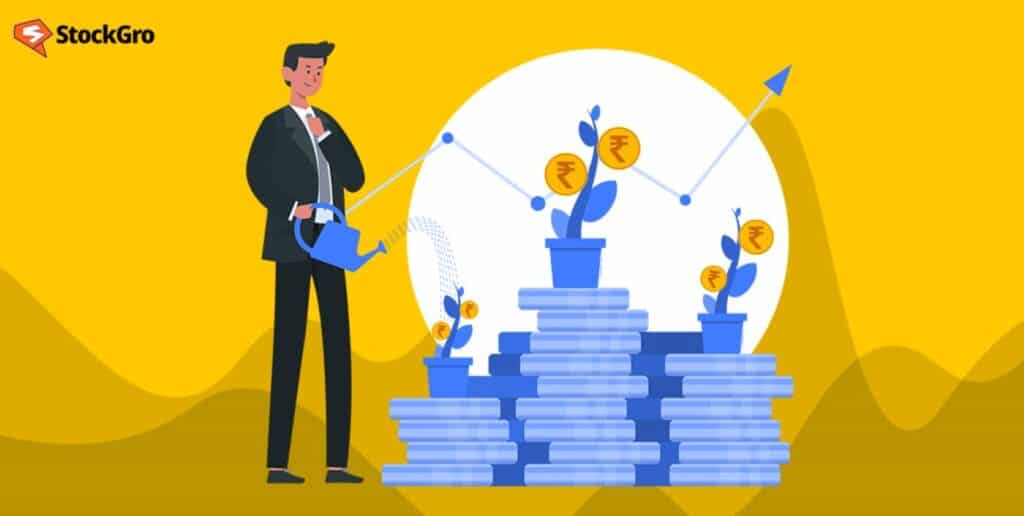
Whether you take a loan or open a new account, you can see that banks and other financial institutions are calculating their rate of interest on a compound basis. The biggest advantage? It helps to grow the sum of your money faster than the conventional interest calculation.
The biggest drawback? There are very few who know about it in detail. However, what if you can understand its different aspects right here in the easiest way possible?
Why compound interest?
Compounding periods help to multiply your money at accelerated rates. The more compounding the period you keep your money, the more the rate of compounding interest you get.
So it is a favourable way to calculate your investments. But on the flip side, it can make calculating your debts quite tricky.
You may also like: Earnings Per Share (EPS): What it means and how to calculate it
How does compound interest work?
Your financial expert would use a compound interest calculator for accurate calculation. To calculate, multiply the principal by one, add the interest rate, and add the number of compounding periods plus one.
Next, the amount of the loan, or actual principal, gets deducted from the resultant value.
What is the period of compounding interests?
[A = P(1 + \frac{r}{n})^{nt}]
This compound interest equation shows periods are basically time intervals between the time you add interest to your account balance. Your bank can compound interest on any basis, including daily, monthly, quarterly, semi-annually, and annually.
If the compound interest formula confuses you, then the following formula can be helpful.
Suppose that you have about INR 1000 in your savings account. From it, you earn a 5 per cent rate of interest. This gives you a balance of INR 1050 in a year. In the second year, you earn an extra 5% ok on the new balance of INR 1050, i.e. INR 52.50. So after the end of the second year, which is the compounding period, INR 1102.50.
Key factors that impact your returns
Whether you use a calculator or employ a compound interest rate formula, understanding some basic factors can be helpful. Remember that each of these factors has its own role to play in the final product.
Also, there are certain variables that can drastically affect your returns. Here’s a briefing on the most important variables:
- Interest: with a higher interest rate, you earn or owe more money.
- Basic principle: it deals with the amount of money that you are starting with. Consider the amount of loan that might have been taken up. Compounding the interest does add up to your savings over time. Yet, it all starts with the starting amount that you borrowed or deposited.
- The pace of compounding: the frequency at which the interest is compounded can play a detrimental role in determining how fast the balance can grow. So when you open a savings account or take a loan, ensure to discuss beforehand how frequently the interest would compound.
- Duration: can you anticipate how long you would keep your money in the savings account or what time it would take to pay back the loan? The longer you let the money sit in your savings account, or the longer you take to pay back debt, the more compounding amount you would get or owe.
- Withdrawals and Deposits: can you anticipate how frequently you would deposit some money into the account or how frequently you would pay off the loan instalments? The speed at which you create your principal balance or pay back the loans has a direct effect on your account balance.
Also Read: Index Options: Understanding its types and function
What is the standard frequency of compounding in various financial instruments?
Now that you have a basic idea of what is compound interest, would you not want to know how frequently various financial instruments compound? To get an idea, you should know that:
- Money market and savings account: by and large, these institutions use compounding schedules on a day-to-day basis.
- CD or Deposit certificate: typically, the schedule of compounding frequency is on a monthly or daily basis.
- Series I bond: here, the interest gets compounded every six months, semi-annually.
- Loans: for various types of loans, the compound interest calculation is on a monthly basis. However, for student loans, some banks do take a different approach.
- Credit Cards: compound interest is added on a daily basis.
How does compound interest support start saving early?
Often, the youth and youngsters tend to neglect the need to save some money for rainy days. Yet, the earlier they get into the habit of starting saving, the faster they reap the benefits of compound interest.
So encourage young children to start saving, no matter how “small” the amount seems to be. Citing the following example to them could be helpful:
Say that a random boy starts saving INR 100 every month when he is twenty. The bank can offer about a 4% rate of interest. If he continues these monthly savings for the next 40 years while reaching the age of 55, he can earn about INR 151,550. Behind this hefty refund, the principal investment remains as low as INR 95000.
Also Read: What is Short-Selling, and how does it work?
What are the differences between simple interest and compound interest?
Both these forms of interest work differently from one another. The calculation of simple interest is entirely on the basis of the principal amount. The interest you earn does not get any reinvestment into the principal amount.
So when you think in the line of Simple Interest, the INR 1000 account balance that you have with the rate of 5% interest would pay you an interest of INR 50 after the end of its tenure. However, this amount of earned interest does not get added back to the principal amount for extra earnings.
Calculation of interest in the “simple” way is still a popular practice for short-term loans like consumer loans and car loans.
Is there a way to make compound interest work smoothly for you?
Here are some pearls of wisdom to make the most of your journey with compound interest.
- Take your time: time power is significant in the world of compound interest. The sooner you start investing, the faster you see its results. Give time to the money and see how it grows in your favour.
- Stay “aggressive” while paying down your debts: compound interest is not favourable for those who borrow money. It does not matter whether the lending comes in the form of credit cards, student loans or other necessities. The quicker you pay them back, the lesser amount you will owe over time.
- Compare the annual percentage yield: the APY delivers a clearer picture of what you pay as interest or earn as interest. This is different from the APR of the annual percentage rate. This is because APR accounts for simple interest, while APY relates to compound interest.
The Bottom Line
Successful and accurate compounding can help you reach your money goals, even while making relatively less investment. However, the same compounding would go against you if you are in the habit of frequent lending.
In a perfect world, you might want your investments and savings to get calculated using compounding while your debts get calculated with Simple Interest. But that is not the way of the world.
So you cannot afford to be negligent while making financial plans.

